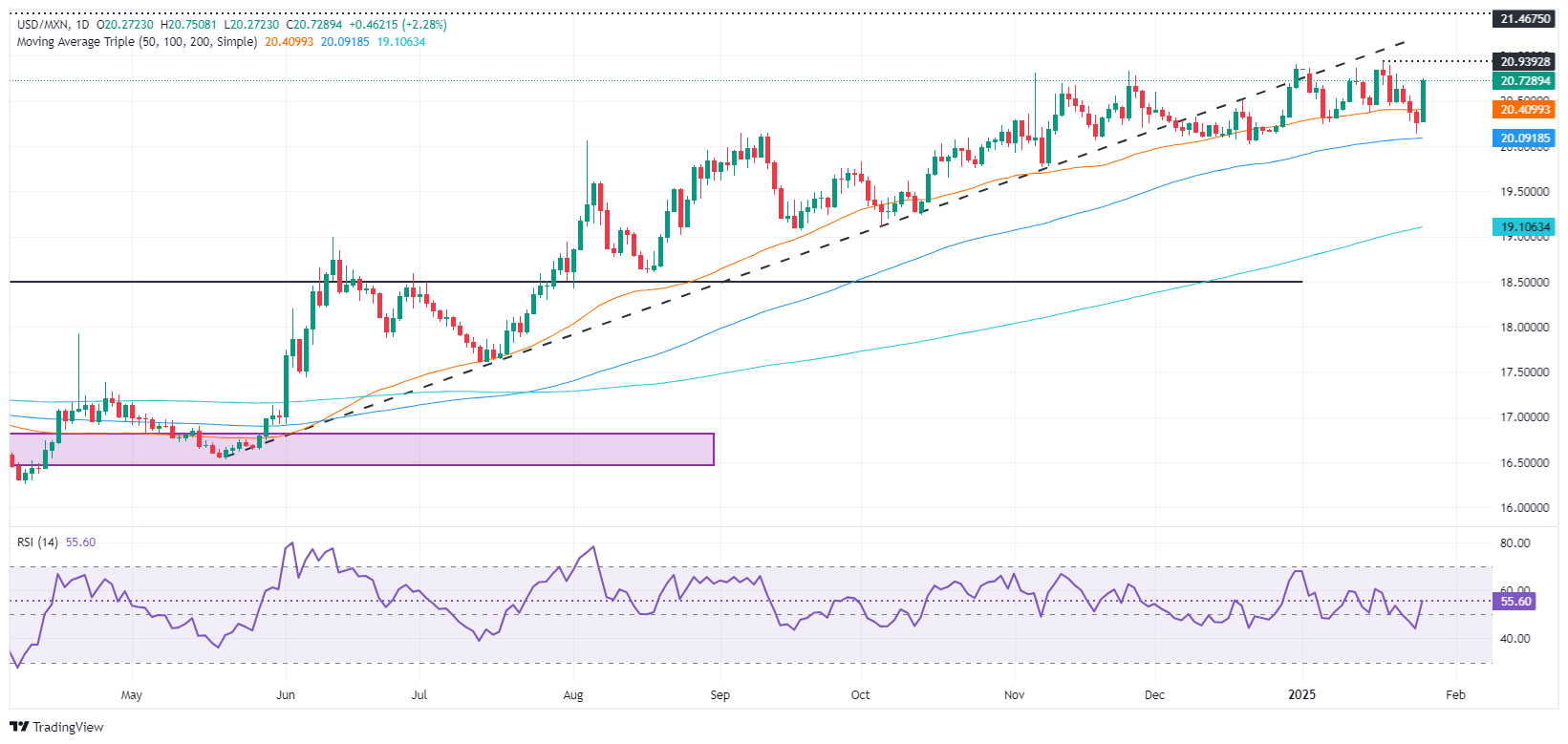Mexican Peso plunges as Trump wavers on Colombia tariff threats
- Mexican Peso under pressure following Trump tariff threat on Colombian goods.
- Banxico’s new monetary program hints at aggressive rate cuts, a headwind for the Peso.
- Traders await upcoming Mexican economic reports on unemployment and preliminary Q4 GDP.
The Mexican Peso plummeted against the Greenback on Monday after US President Donald Trump announced on Sunday that he would impose tariffs on Colombian goods after Colombian President Gustavo Petro wouldn’t allow planes from the United States (US) to carry migrants on deportation flights. Trump then backtracked on the tariffs on Monday morning once the two leaders came to a deal to allow the deportations. This and Banco de Mexico’s (Banxico) dovish rhetoric sponsored a leg-up in the exotic pair. The USD/MXN trades at 20.70, up by more than 2%.
Over the weekend, US President Donald Trump informed his social network of Petro’s decision, which sparked several US retaliation measures including the tariff threat. Consequently, the Mexican Peso, used as a proxy for other Latin American currencies, weakened in early trading on Monday.
In the meantime, the Instituto Nacional de Estadistica Geografia e Informatica (INEGI) revealed that the Balance of Trade posted a surplus in December. However, seasonally adjusted, the deficit narrowed compared to November figures.
Meanwhile, Banxico presented its Monetary Program for 2025, in which the Central Bank hinted that the Governing Board is eyeing cuts to its main reference rate of a greater magnitude than previously seen in 2024.
Banxico’s Governor Victoria Rodriguez Ceja said that they see an adverse scenario with Trump, adding that some of his policies could pressure Mexico’s economy.
She added, “On the one hand, greater economic weakness would tend to moderate pressures on prices and, on the other hand, a greater exchange rate depreciation represents an upward risk for inflation. These effects in opposite directions could even offset each other, but we would have to be attentive, if necessary, to the measures that could be implemented.”
Ahead this week, Mexico’s economic docket will feature the Unemployment Rate for December, along with the release of preliminary Q4 2024 Gross Domestic Product (GDP) figures.
Daily digest market movers: Mexico’s Balance of Trade failed to bolster the Peso
- INEGI revealed that the Balance of Trade for December was 2.567 billion, up from a -0.133 billion deficit. Seasonally adjusted, the trade deficit narrowed from -0.775 billion to -0.684 billion for the same period.
- Economists polled by Reuters project GDP to dip -0.2% QoQ from an expansion of 1.1%. On an annual basis, GDP is foreseen to edge lower from 1.6% to 1.2%.
- Citi revealed its Expectations Survey, in which Mexican private economists revised GDP figures for 2025 downward to 1%.
- Regarding inflation expectations, analysts estimate headline and core inflation to dip below 4%, each at 3.91% and 3.68%, while the exchange rate would likely end near 20.95.
- Economists estimate that Banco de Mexico (Banxico) will lower rates by 25 basis points (bps) from 10.00% to 9.75%, though some analysts expect a 50 bps cut at the February 6 meeting.
- Money market futures have priced in 54 bps of Fed rate cuts in 2025, according to CME FedWatch Tool data.
USD/MXN technical outlook: Mexican Peso treads water as USD/MXN approaches to year-to-date (YTD) high
The USD/MXN pair resumed to the upside after clearing the 50-day Simple Moving Average (SMA) at 20.38 since early trading during the Asian session. Trump’s tariff threats on Colombia weakened the Mexican Peso amid a risk-averse scenario, as the Peso plunged to a four day low of 20.74.
If traders clear the USD/MXN record high of 20.90, buyers would be in charge and challenge the 21.00 mark. On further strength, the next resistance would be the March 8, 2022 peak at 21.46, ahead of the 22.00 figure.
Conversely, if USD/MXN falls below the 50-day SMA of 20.38 and extends its losses toward the 100-day SMA at 20.06, bears could aim to push prices toward the 20.00 mark.

Banxico FAQs
The Bank of Mexico, also known as Banxico, is the country’s central bank. Its mission is to preserve the value of Mexico’s currency, the Mexican Peso (MXN), and to set the monetary policy. To this end, its main objective is to maintain low and stable inflation within target levels – at or close to its target of 3%, the midpoint in a tolerance band of between 2% and 4%.
The main tool of the Banxico to guide monetary policy is by setting interest rates. When inflation is above target, the bank will attempt to tame it by raising rates, making it more expensive for households and businesses to borrow money and thus cooling the economy. Higher interest rates are generally positive for the Mexican Peso (MXN) as they lead to higher yields, making the country a more attractive place for investors. On the contrary, lower interest rates tend to weaken MXN. The rate differential with the USD, or how the Banxico is expected to set interest rates compared with the US Federal Reserve (Fed), is a key factor.
Banxico meets eight times a year, and its monetary policy is greatly influenced by decisions of the US Federal Reserve (Fed). Therefore, the central bank’s decision-making committee usually gathers a week after the Fed. In doing so, Banxico reacts and sometimes anticipates monetary policy measures set by the Federal Reserve. For example, after the Covid-19 pandemic, before the Fed raised rates, Banxico did it first in an attempt to diminish the chances of a substantial depreciation of the Mexican Peso (MXN) and to prevent capital outflows that could destabilize the country.
